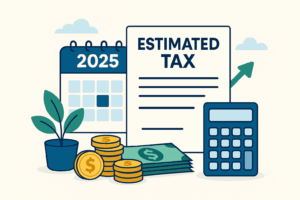
Estimated Tax 2025
Estimated Tax Payments for High-Income Individuals: What You Need to Know in 2025
The estimated tax payment rules for high-income individuals can feel complicated, but understanding them is crucial to avoid penalties and interest. In this post, we’ll explain how estimated taxes work, why they matter, and what steps you should take in 2025 to stay compliant and minimize surprises.
Why Estimated Taxes Are Important in 2025
The U.S. tax system is pay-as-you-go. If you earn income that isn’t subject to withholding — like business profits, investment income, or rental income — the IRS expects you to make quarterly estimated payments. High-income individuals are particularly at risk because their income is often more complex and exceeds withholding.
If you don’t pay enough throughout the year, you could face underpayment penalties, even if you pay your full tax bill by April. This is why planning your estimated taxes is essential.
Who Needs to Make Estimated Tax Payments?
If any of the following apply to you, estimated tax payments may be required:
✅ You expect to owe at least $1,000 in tax after subtracting withholding and refundable credits.
✅ You expect your withholding to be less than 90% of your total tax liability for the year.
✅ You have significant income from self-employment, investments, or partnerships.
How to Calculate and Pay Estimated Taxes
To calculate estimated payments, start by estimating your total income, deductions, credits, and tax liability for the year. Subtract any expected withholding. The remaining amount is what you’ll need to pay in estimated payments, split into four quarterly installments.
The IRS provides Form 1040-ES to help calculate payments. Many high-income taxpayers also work with tax professionals to adjust their payments throughout the year as their income changes.
Payments are due on the following schedule for the 2025 tax year:
– April 15, 2025 (for Q1)
– June 16, 2025 (for Q2)
– September 15, 2025 (for Q3)
– January 15, 2026 (for Q4)
Strategies to Avoid Penalties
✔ Use the safe harbor rule: pay 100% of your prior year’s tax (or 110% if your adjusted gross income exceeded $150,000) to avoid penalties, even if your actual tax is higher.
✔ Adjust withholding if possible: if you also earn wages, increase withholding to reduce or eliminate the need for estimated payments.
✔ Reevaluate quarterly: if your income changes significantly, adjust your next payment to avoid overpaying or underpaying.
Why Act Now?
The estimated tax rules are not forgiving — and penalties can add up quickly. By planning your 2025 payments now, you can avoid surprises and stay focused on your financial goals without unnecessary stress.
Links:
– Contact TaxLane
– IRS Estimated Taxes Page
—
**Disclaimer:** The information provided in this blog post is for informational purposes only and should not be construed as legal, tax, or accounting advice. Tax situations are often complex and highly specific to the individual or business. You should contact a qualified tax expert directly to discuss your particular circumstances. Nothing herein is intended to, nor does it, create an attorney-client or advisor-client relationship. For individual guidance, please contact us directly.


